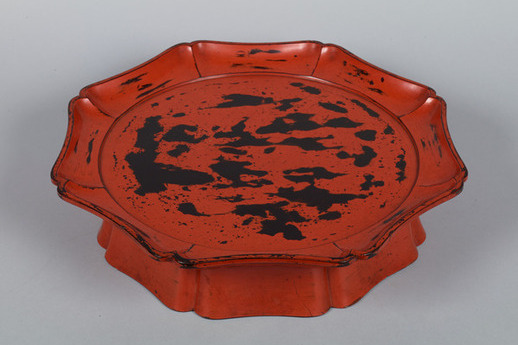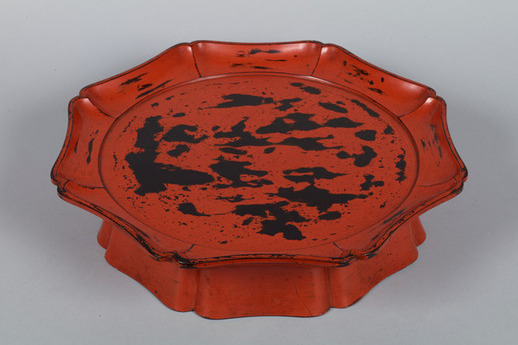2025.03.27
コラム/エッセイ「多様なるジャパン」 第5回 根来
白洲信哉=文筆家、日本伝統文化検定協会副会長

朱漆輪花盤(室町時代・16世紀)東京国立博物館所蔵
出典:ColBase(https://colbase.
字引を引くと、「磁器」をChinaと呼び、Japanは、「漆器」とあり、温暖多湿なモンスーン気候帯のみに植生する漆は、手先の器用な日本人が育んだ天然素材である。縄文時代には土器の補修や鏃(やじり)を矢柄に取り付ける接着剤として、精製技術を会得すると塗料に進化、世界最古1万2600年前、縄文早期の遺跡から朱漆の櫛(鳥浜貝塚)も出土、まさしく「漆の国」なのだ。中でも僕は黒漆に朱漆を重ねた「根来(ねごろ)」を賞翫(しょうがん)する。これこそが経年変化の日本美を如実に伝え、手仕事ニッポンの実用的な機能のみならず、呪術的象徴でもあるからだ。
根来は、積年の使用具合により上塗りの朱色がはげ、下塗りである黒色の塗り肌が出てくることにより、自然に出来上がった抽象文様をいう。従って、作品全てオンリーワン、時が育んだ「美」なのである。世界のスタンダードははげたら塗り直すと思うが、僕らは古色を尊び、そのはげ具合に一喜一憂、好みの分かれ目である。
漆の赤色には酸化第二鉄を使ったベンガラと酸化水銀を使った水銀朱があるが、後者は「黄金千杯、朱千杯」といわれ、かつて金に匹敵する重要鉱物として宝物のように扱われ、不思議な霊力を持つカミとして崇められた。鉱脈のある所を「丹生(にう)」と言い、百を超える丹生神社の半数は根来の語源である根来寺のある和歌山県に集中、元締めは紀ノ川沿い対岸の丹生都比売(にうつひめ)神社だ。弘法大師空海が高野山を開いたのは、狩場明神(かりばみょうじん)という縄文のカミ様のお導きとされているが、大師は丹生の鉱脈利権に目を付け、丹生の女神を高野山に招来したのである。
貴重な朱は貴族や宮中の器物として、新嘗祭(にいなめさい)の食器は三位以上が朱漆の使用を許されるなど上位の者しか使えなかった。黒漆にわざわざ朱漆を重ねて塗ったのは、強度や耐水耐火性を高めるだけでなく、先の櫛や縄文土器に古墳の石棺など赤く装飾したと同様に、死者の蘇り(よみがえり)や魔除け(まよけ)など僕らのDNAに刷り込まれたさまざまな霊的願いがこもった原始の色だったからだ。
さらに大事なことは塗料である漆の縁の下の力持ち「木地(きじ)」だ。家作りと同じく土台がしっかりしていないと、外見の朱色がいくら魅力的でも長年の使用に耐えられない。強靭(きょうじん)な木地造りこそが使い易さに耐久性、機能性を加えた「用の美」の根幹で、時のつくった「美」根来の本質なのだ。ちなみに「根来に根来なし」と言われるように「根来」は中世より伝来した堅牢で優れた朱漆器全般の総称で、その技術が伝播した輪島塗のような産地名でなく、昨今、海外では「NEGORO」で通っている。
【English version】
Diverse Japan Vol. 5 Negoro
Shinya Shirasu = writer, vice-president of the Japan Traditional Culture Certification Association

Red lacquer rinka-ban (Muromachi period, 16th century), Tokyo National Museum collection.
Source: ColBase (https://colbase.nich.go.jp/)
The Japanese character dictionary calls porcelain ‘China’ and Japan ‘lacquerware’. Lacquer, which grows only in warm and humid monsoon climates, is a natural material nurtured by the dexterity of the Japanese people. During the Jomon period, lacquer was used to repair earthenware and as an adhesive for attaching arrowheads to arrowheads, and when the technique of refining lacquer was mastered, it evolved into paint. I particularly admire Negoro, which is black lacquer overlaid with vermilion lacquer. This is because it conveys the Japanese beauty of ageing and is not only a practical function of handmade Japanese craftsmanship, but also a magical symbol.
Negoro refers to the abstract patterns that are naturally formed when the vermilion of the top coat peels off and the black of the undercoat appears as a result of years of use. Therefore, every piece is unique, a beauty nurtured by time. The world standard is to repaint when the lacquer peels off, but we respect the old colour and are happy or sad to see it peel off, and our tastes differ.
There are two types of red lacquer: bengara, made from ferric oxide, and mercury vermilion, made from mercury oxide. Half of the more than 100 Niu shrines are concentrated in Wakayama Prefecture, where Negoroji Temple, the origin of the word Negoro, is located, and the Niutsuhime Shrine on the opposite bank of the Kino River is the original centre. It is said that Kobo-Daishi Kukai founded Koyasan under the guidance of a Jomon deity called Karibari Myojin, who, having spotted the mineral rights in Niu, invited the Niutsu no Mikami to Koyasan.
The precious vermilion was used by the nobility and court nobility, and only those of the third rank and above were allowed to use vermilion lacquer for the Niinamesai ceremony. The reason why vermilion lacquer was deliberately applied over black lacquer was not only to increase strength and water and fire resistance, but also because it was the primitive colour of various spiritual wishes imprinted in our DNA, such as reviving the dead and repelling evil spirits, as in the red decoration of combs, Jomon pottery and sarcophagi from ancient burial mounds.
What is even more important is the ‘kiji’, the wood behind the lacquer, which is the paint. Just like building a house, if the foundation is not solid, the wood cannot withstand many years of use, no matter how attractive the vermilion colour may be on the outside. Strong wood construction is the basis of the beauty of use, which adds durability and functionality to ease of use, and is the essence of Negoro, the ‘beauty’ created by time. Incidentally, as the saying goes, ‘Negoro ni negoro nai’ (Negoro has no Negoro), ‘Negoro’ is a general term for all the robust and excellent vermilion lacquerware introduced in the Middle Ages, and is nowadays known overseas as ‘NEGORO’, rather than the name of the production area, like Wajima-nuri, where this technique was transmitted.
カテゴリー: コラム/エッセイ





